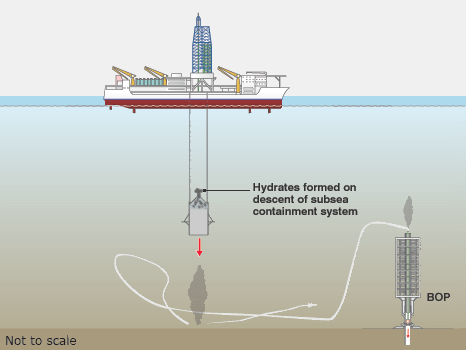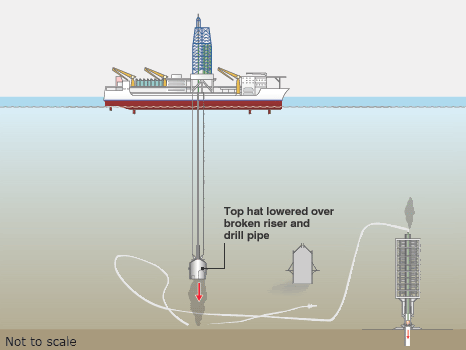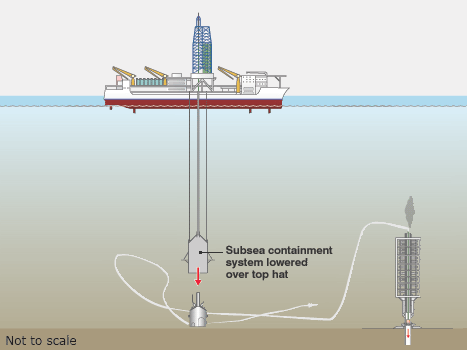

Instead, engineers have lowered a smaller device onto the site. Dubbed the Top hat, it will sit over the tear in the pipe and partially stop the leak. To prevent the build up of hydrates, methanol is pumped into the top hat to disperse the water and gas.


BP plan to lower the original subsea containment dome over the top hat to provide a better seal over the leaking site and pump oil up to the surface. This time, it will be attached to a pipe that can pump warm water into the dome to prevent the build-up of hydrates.
Scientists have found vast underwater plumes of oil, one 10 miles (16km) long and a mile wide, in the Gulf of Mexico, following last month's rig disaster.
A Georgia University expert warned oxygen levels had fallen 30% in some areas of the sea, and it could take decades to repair the damage.
BP is still trying to insert a tube into the gushing well to siphon the crude to a ship on the surface.
The US government has demanded BP make clear its commitment to pay damages.
Researchers from the National Institute for Undersea Science and Technology say they have detected several sprawling oil slicks lurking just beneath the surface of the sea and at depths of 4,000ft (1,200m).
Dead zones
The find suggests the scale of the potential environmental disaster is much worse than previously feared since the Deepwater Horizon drilling rig blew up on 20 April, killing 11 workers.
Samantha Joye, a marine science professor at the University of Georgia, said: "It could take years, possibly decades, for the system to recover from an infusion of this quantity of oil and gas.
"We've never seen anything like this before. It's impossible to fathom the impact."
The experts say the oxygen depletion is likely to continue, endangering sea life and raising the prospect of underwater dead zones.
The scientists said the chemical dispersants BP has been dumping underwater may be preventing the oil from rising to the top of the ocean.
Official estimates doubted
The oil giant has said the chemicals, which it began deploying on Friday, have already resulted in less oil surfacing.
Some scientists cast doubt on official estimates of the oil flow rate, saying the widely repeated figure of 5,000 barrels per day dramatically understates the real amount.
On Saturday, BP failed in its latest attempt to thread a 6in-wide (15cm) tube into a damaged oil pipe a mile beneath the surface.
Like a long straw, it is intended to slurp oil to a ship on the surface, and a stopper surrounding it would stem the leaking crude.
The tube could capture more than three-quarters of the leak; BP must also contain a smaller spill on the seabed nearby.
A week ago, BP tried to cap the well with a 100-tonne box, but gave up after it became encrusted with ice crystals.
On Saturday, the Obama administration demanded immediate clarification from BP over its commitment to pay damages for the spill.
Officials said they wanted to be sure BP would honour commitments not to limit costs to a US statutory cap of $75m (£50m).
It is not clear what prompted the letter as BP said last week the cap was irrelevant and it would settle all costs.
Mississippi has become the third US state to have oil wash up on its coast, along with Louisiana and Alabama.
The spill is threatening to eclipse the 1989 Exxon Valdez leak off Alaska as America's worst environmental disaster.





0 comments:
Post a Comment